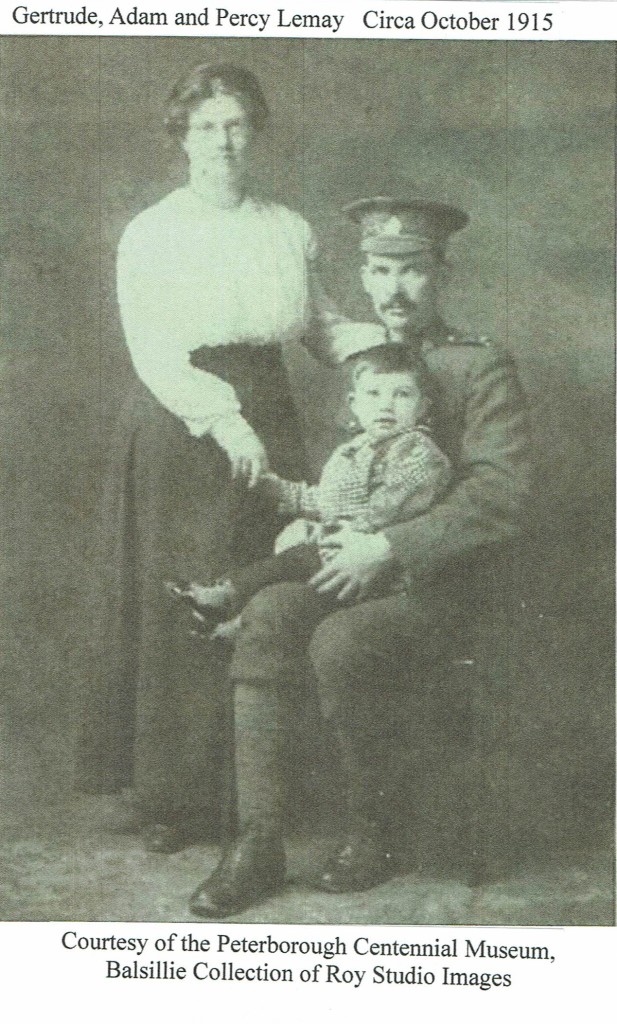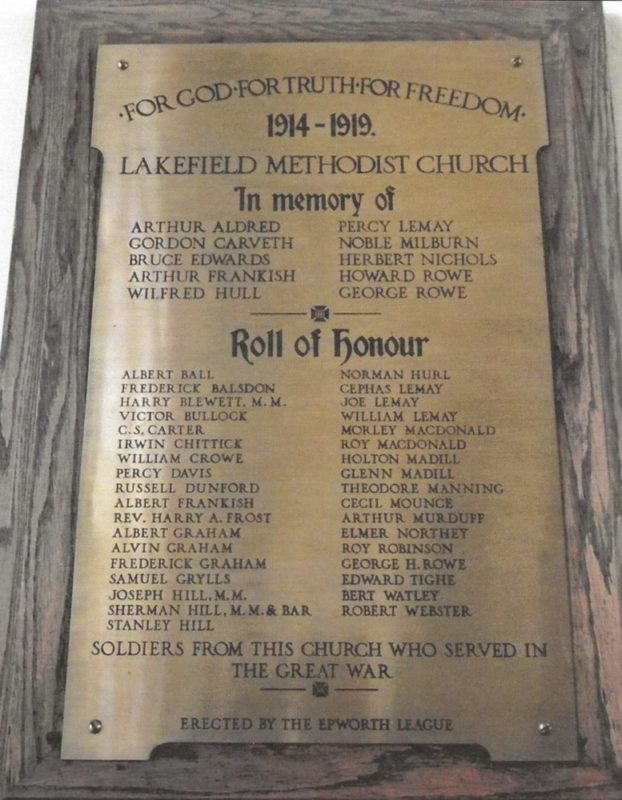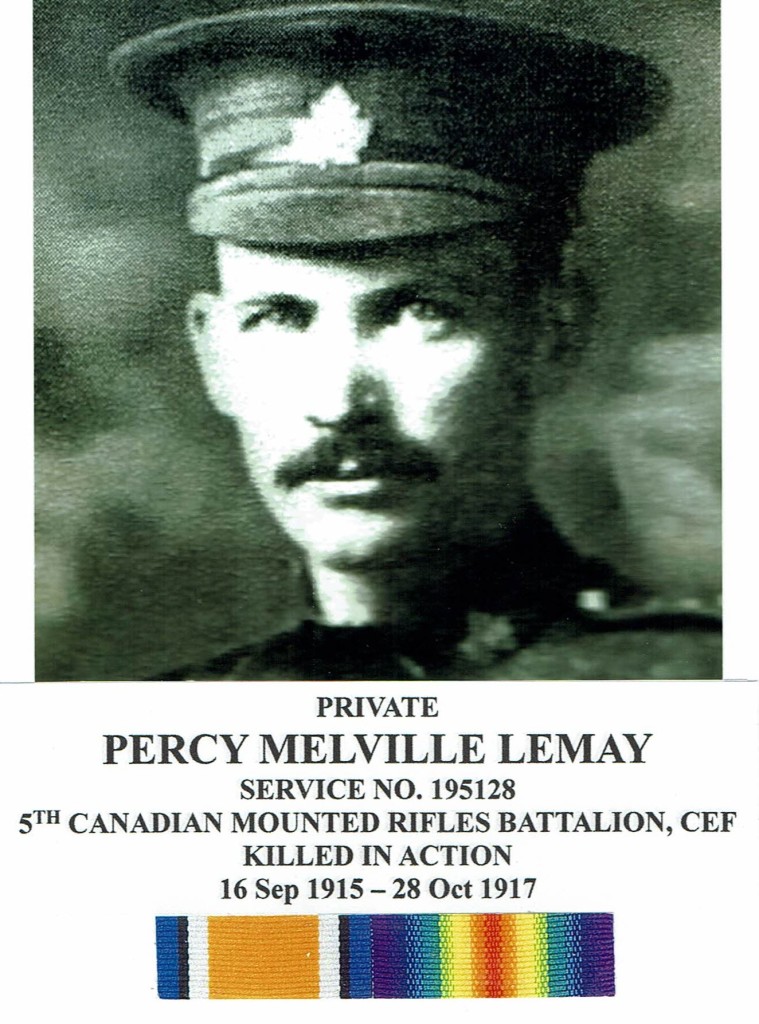
MILITARY HISTORY
Private Percy Melville Lemay – 195128 – ACTIVE SERVICE (World War I)
On September 16, 1915 Percy Melville Lemay completed the Attestation Paper for the Canadian Army Canadian Expeditionary Force (CEF). He was 26 years, 9 months old when, as a married man, he enlisted for the duration of the War. Percy Melville was born in Dummer Township, Ontario and gave his birth-date as December 26, 1889*. On his Attestation Paper, he indicated that ”he did not presently belong to an Active Militia and that he had never served in any Military Force”. There is nothing on his File to indicate where he was educated or to what level. As far as his Trade or Calling is concerned, he lists Labourer. Percy Melville was 5′ 9” tall with a 37” chest (expanded); his weight is listed as 121 pounds. He had a dark complexion, with blue eyes and dark brown hair. Percy Melville’s Medical Examination was completed September 15, 1915 in Peterborough, Ontario. He had no medical issues or physical limitations and as such he was deemed fit for Overseas duty with the CEF. His next-of-kin was listed as his wife, Mrs. Gertrude Lemay, of Lakefield, Ontario. Percy Melville Lemay signed the Oath and Certificate of Attestation on September 16, 1915, in Peterborough. The Certificate of Magistrate was signed by the Justice on September 21, 1915. Percy Melville Lemay was taken-on-strength with the 57th Battalion (Bn) as a Private (Pte) and was assigned Service Number 195128. When the 93rd Bn (Peterborough) was authorized and formed up on December 22, 1915, Pte Lemay was transferred to it. *Actual date of birth is December 26, 1888.
The 93rd Bn, after training through the winter of 1915 and spring of 1916 at 5 different area Centres, departed by train from Peterborough on May 29, 1916. The 93rd Bn made a short stop at Barriefield Camp located at Kingston, Ontario before moving on to the main CEF Training Centre located at Valcartier, Québec. This was to complete Basic Infantry training, before being transported overseas to the UK, by ship. The 93rd Bn embarked from Halifax, Nova Scotia, on July 15, 1916, aboard the SS Empress of Britain.
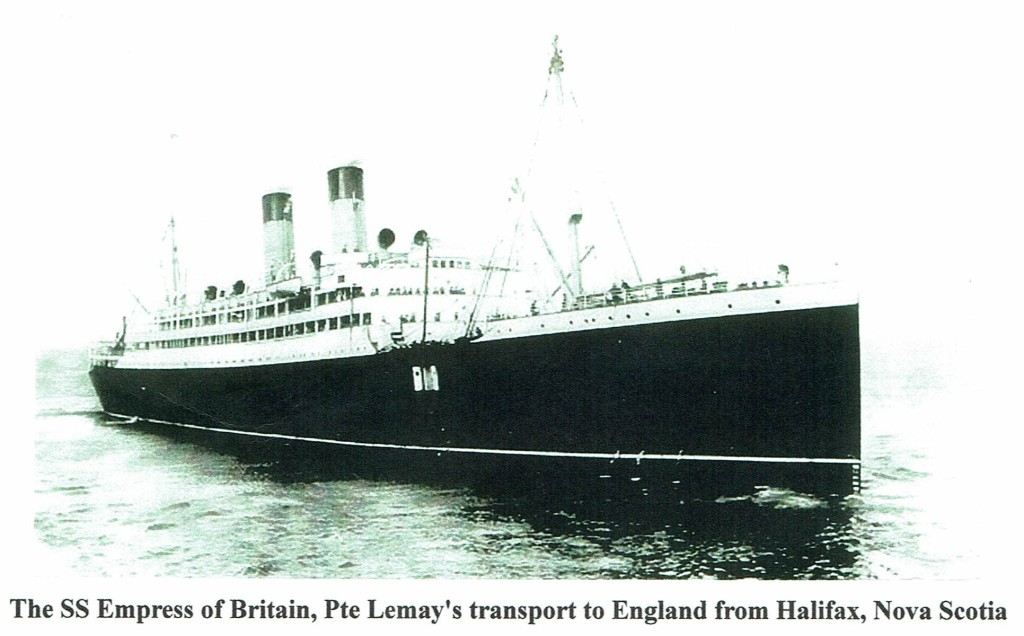
Pte Lemay disembarked in Liverpool, England on July 25, 1916. On September 7, 1916 he was struck-off-strength from the 93rd Bn and taken-on-strength to the 5th Canadian Mounted Rifles Battalion (5th CMR Bn) stationed at Otterpool, England.
Although it is not mentioned in his records; the next 3 months would have been utilized for Advanced Training and duties at Otterpool. The 5th CMR Bn was a Québec Unit raised in the Eastern Townships of Québec from volunteers of the 7th and 11th Hussars of Sherbrooke, Québec. On January 1, 1916 the 5th CMR Bn was converted to an Infantry Unit and attached to the 8th Canadian Infantry Brigade.
Pte Lemay embarked from England and disembarked in France on September 8, 1916 where he was taken-on-strength with the 5th CMR Bn in the Field. On September 25, 1916 he left for the 3rd Echelon Battalion (3 E Bn) arriving September 28, 1916. On October 2, 1916 he left for and joined the 5th CMR Bn.
There are no entries in Pte Lemay’s Military File from October 2nd, 1916 and September 14, 1917. To trace Pte Lemay’s movements, during this period, the 5th CMR Bn War Diaries were used.
When Pte Lemay joined the 5th CMR, on October 2nd, they had just been moved to a rest area near the Village of Albert, France following very heavy fighting on October 1st, 1916. Entries in the War Diaries indicate that from October to the end of December 1916 the 5th CMR made a series of moves to and from the Front-Line trenches. This pattern continued through January until the end of March 1917. April 1917 began with the 5th CMR in a rest area going through ”musketry, Platoon and Company drills, bayonet fighting, and practicing blowing up trenches”. On April 5th, 1917 the Unit received its operational orders for the pending attack on Vimy Ridge. On April 8th the 5th CMR moved forward, at 10:00 PM from Woodman Camp to the Front-Line trenches. Zero hour was 5:30 AM April 9th, 1917. It is reported: ”All ranks are calmly confident”. Pte Lemay and 5th CMR were in position by 4:30 AM. ”Zero Hour – Intense Artillery bombardment, one continuous roar. The ground trembled and mingled with the roar of the guns is the swishing and screeching of the shell-filled air. Smoke and debris thrown up by the exploding shells give the impression of a solid wall”. At 5:50 AM the Infantry started its advance. Very heavy fighting went on until April 10, 1917. By midnight, on April 10th, the Canadian Corps had captured 3,000 German prisoners, seven 5.9 inch guns, two 8 inch guns, one anti-tank gun, numerous machine guns and mortars. April 12, 1917 the Unit was back at Woodman Camp. A summary of the 5th CMR Bn casualties were: 2 Officers killed; Other Ranks – 17 killed, 3 died of wounds, 28 wounded, 5 missing, and 6 shell shocked.
From April 12 to April 16, 1917 the Unit rested and cleaned up; ”400 men had a bath and change of clothes at Villers-au-Bois”. From April 17th to April 23rd the Unit was back at the Front. April 24, 1917 the 5th CMR was in billets at Villers-au-Bois, where they would remain to the end of the month. Here they were back to the regular routine of ”musketry, physical exercises, bayonet fighting, Platoon and Company drills etc”. From May 1st to May 3rd, 1917 the Unit was at Quarries Line. May 4, 1917 the Unit was moved to the Vimy Support trenches. They would remain there until May 11th. During this time they were under ”almost daily, but not destructive enemy barrages”. No casualties were recorded. May 12th the Unit was relieved and withdrew to ”billets” in suburban huts at Villers-au-Bois. On May 20, 1917 they moved to Winnipeg Camp in the Quarries Line area. May 27th they moved forward to the Vimy Support Line, where they engaged in work parties ”building dugouts and jumping off trenches”. June 1917 began with the 5th CMR located at what is referred to as ”Vimy Defences”. ”There are reports of enemy firing gas shells on Vimy and La Chaudière trenches. Canadian Artillery very active. 5th CMR snipers having great success. Not many casualties in the 5th trenches”. June 8th the 5th CMR was relieved on the line and proceeded to the area of Quarries Line ”for a well deserved rest”. June 14th the 5th CMR moved to Villiers-au-Bois. On June 18, 1917 preparations began for a move back to Vimy Defences. From June 19th to the end of the month activity in the 5th CMR trenches was relatively quiet. July 1917 began with the 5th CMR back at Villers-au-Bois where, on July 2nd, they continued on to the ”Seaforth Camp” near Bois de Berthonval. For the next several days, until July 9th, “time was devoted to practice of attack in all its phases”.
July 10th the 5th CMR relieved the Royal Canadian Regiment (RCR) in a Reserve position. On July 20, 1917 the Unit moved to the St. Lawrence Camp where they stayed until July 26th when they moved to Raimbert. The 5th CMR would remain at Raimbert until August 20th. During this time they underwent; ”physical training, Platoon drills, musketry, fire control in direction and recognition of targets”. They also practiced attacks, and held Church Parades. On August 12th a Brigade Sports Day was held with the 5th CMR winning most of the events including; football, baseball and tug-of-war. On August 20th the 5th CMR moved to the Front-Line and on August 25th relieved the 4th CMR in ”close support”. On August 27th, 1917 they were withdrawn to the area of Les Bresbis, moving on the Bouvigny – Bouffelles at the end of the month. From September 1st to 5th, 1917 the 5th CMR was in the area of Bois de Alleux, once again practicing attacks. On September 6th they moved forward to close support positions, where they stayed until September 18th, 1917.
On September 14, 1917 Pte Lemay was granted a Leave in Paris, France from September 14 to 24, 1917.
Pte Lemay rejoined the 5th CMR Bn at Maisnel Bouche on September 25, 1917 where they would remain until October 16, 1917. It is believed that the 5th CMR was now about to be engaged in the Second Battle of Passchendaele. On October 16, 1917 they moved to St. Sylvestre Cappel followed by a move to the Wieltze area on October 23, 1917. On October 26, 1917 the 5th CMR moved into the ”California Trench” on the Front-Line. They spent most of their time ”pumping water out of the dugouts so as to make them habitable, while preparing for an attack”. These were the final days of the prolonged Battle of Passchendaele.
The 5th CMR Bn War Diaries show the following entry for October 28th, 1917: ”Weather fine. Preparations for attack were completed. At 6:00 PM the 5th CMR Bn left the support area and relieved the 2nd CMR Battalion with A and C Companies on the Front-Line, B and D Companies are in the old British Line, with Headquarters at Kron Prinz Farm. “Battalion Headquarters were continuously shelled by the enemy resulting in casualties. 4 Orderlies (assistants for Medical Officers) were killed and 12 wounded”. This entry would indicate that Pte Lemay could have been functioning in the capacity as an Orderly assigned to a Medical Officer since he was one of the soldiers killed. The only other entry made on this day was when a Patrol was sent out at 11:45 PM to scout out No-Man’s-Land but it returned at 3:00 AM without having seen any enemy or firing a shot.
Private Percy Melville Lemay is buried in Oxford Road Cemetery, Belgium. The Cemetery is located north east of the town of Leper, Belgium. His name appears on Page 274 of the First World War Book of Remembrance located in Ottawa, Ontario.
There is no mention in the File with regards to what Military Medals Private Percy Melville Lemay was eligible to receive or was awarded. Based on his Military Service, he was awarded the:
British War Medal; and
Victory Medal.
He would have also received the CEF Class “A” War service Badge.
Pte Lemay’s Memorial Cross was sent to his wife: Mrs. Gertrude Lemay of Peterborough, Ontario. The Memorial Scroll was dispatched January 18, 1920 followed by the Memorial Plague on August 13, 1921.
Based on his Military File, Pte Lemay served a total of 2 years, 1 month and 12 days with the Canadian Expeditionary Force: 10 months in Canada, 1 month and 14 days in England and 1 year, 1 month and 20 days in France plus 10 days in transit.
An excerpt from an article in Maclean’s by Barbara Ameil, September 1996:
The Military is the single calling in the world with job specifications that include a commitment to die for your nation. What could be more honorable.
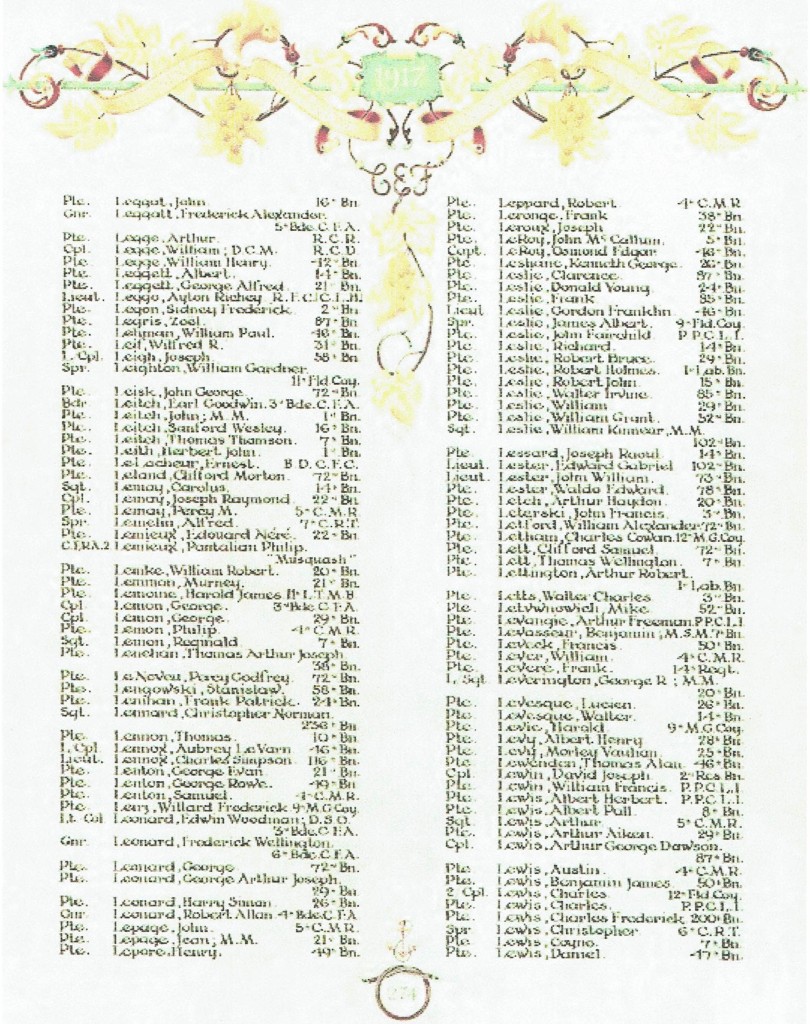
PERSONAL HISTORY
PERCY MELVILLE LEMAY
Percy Melville Lemay was born December 26, 1888 in Dummer Township, Peterborough County, Ontario to John Louis Lemay and Mary Etta Snelgrove. He went by Percy and was educated in the Rural Public School System.
Percy Melville Lemay married Gertrude Alice Yenney, a teacher, in Lakefield on June 28, 1911. Percy and Gertrude had two sons; Henry John, born September 27, 1912 at Nicholls Hospital, Peterborough but died at 17 days of age on October 14, 1912. The second son, Adam, was born circa 1915. Apparently Adam’s birth was not registered since no record was found; he was probably born 1915 at Nicholls Hospital, Peterborough as was his brother. Gertrude Alice was the daughter of Henry Alfred Yenney and Emma Jane Crawford.
On September 16, 1915, Percy went to Peterborough and enlisted with the Military one day after his cousin Cephas Melville Lemay and Uncle Joseph Lemay had joined. Percy Melville Lemay was killed in action in France on October 28, 1917, he is interred in the Oxford Road Cemetery, Belgium.
According to the 1921 Ontario Census, Gertrude Lemay and her six-year-old son Adam were living with Gertrude’s parents Emma and Henry Yenney at 190 Barnardo Avenue in Peterborough, Ontario.
THE PERCY MELVILLE LEMAY FAMILY OF LAKEFIELD
Percy Melville’s paternal grandparents are Francis Lemay, born about 1794 and Mary Elizabeth Tates, born about 1830. Francis and Mary Elizabeth had seven children: John, born about 1860; Elizabeth, born about 1861; Harriette, born about 1863; Agnes, born about 1865; Francis (Jr), born about 1867, Joseph, born about 1870 and Margaret, born about 1872. His maternal grandparents are James and Emma Snelgrove.
Percy Melville’s parents, John Louis Lemay, 26 years old and Mary Etta Snelgrove, 18 years old married in Peterborough, Ontario on October 28, 1885. John and Mary had three children: Emma Liddel, born October 23, 1886; Percy Melville, born December 26, 1888 and Mary E., born May 8, 1892. Emma Liddell died of Appendicitis at 18 years old on August 14, 1905.
After the birth of Mary E. on May 8, 1892, Mary Etta died a week later on May 15, 1892 at 25 years of age; no information has been found as to the cause of her demise. John, a widower with three small children then married Mary Etta’s youngest sister, Elizabeth Ann Snelgrove.
Percy Melville’s father, John Louis Lemay, 33 years old and Elizabeth (Lizzie) Ann Snelgrove, 21 years old married in the Lakefield Methodist Church in Lakefield, Ontario on March 29, 1893. In 1901 the family was living in Dummer Township where John was farming but by 1911 John and his family had moved to Lakefield and John was working at a local sawmill. John and Elizabeth Ann had six children: William John, born February 27, 1896; Amelia, born May 26, 1898; Myrtle Alice, born July 18, 1901; Mable Irene, born January 16, 1905; Lottie Evylin, born May 20, 1907 and Joseph Norman, born December 9, 1909.
Percy Melville and his half-brother, William John, are cousins of Cephas Melville Lemay and nephews of Joseph Lemay. Percy Melville is also a grandson of Francis and Mary Elizabeth Lemay.
Percy Lemay was a member of the Lakefield Methodist church and is included on the Memorial Plaque which honours their members who served in the Armed forced during World War 1. The plaque currently hangs in the sanctuary of the Lakefield United Church 47 Regent Street, Lakefield Ontario.
